An Investigation of Communication Issues within an Organization
VerifiedAdded on 2023/01/16
|11
|2001
|100
Report
AI Summary
This report presents an analysis of organizational communication issues based on employee interviews. The research employs a qualitative methodology, specifically structured interviews, to gather data on workplace challenges. The report explores intercultural communication, negotiation, and conflict resolution within the organization, highlighting the importance of effective communication in a multicultural environment. Findings reveal issues such as communication gaps and their impact on productivity. The discussion section delves into the complexities of persuasion, meetings, and conflict management, supported by relevant theories. Recommendations are provided to address identified shortcomings, focusing on improving communication, fostering understanding, and mitigating potential conflicts. The report emphasizes the significance of clear communication, employee engagement, and the use of appropriate negotiation and persuasion techniques for organizational success. The report also discusses the importance of maintaining ethical standards throughout the research process, ensuring the confidentiality of the interviewees and the integrity of the data. The report concludes with a call for a systematic and standardized approach to address communication issues and foster a more collaborative and productive work environment.
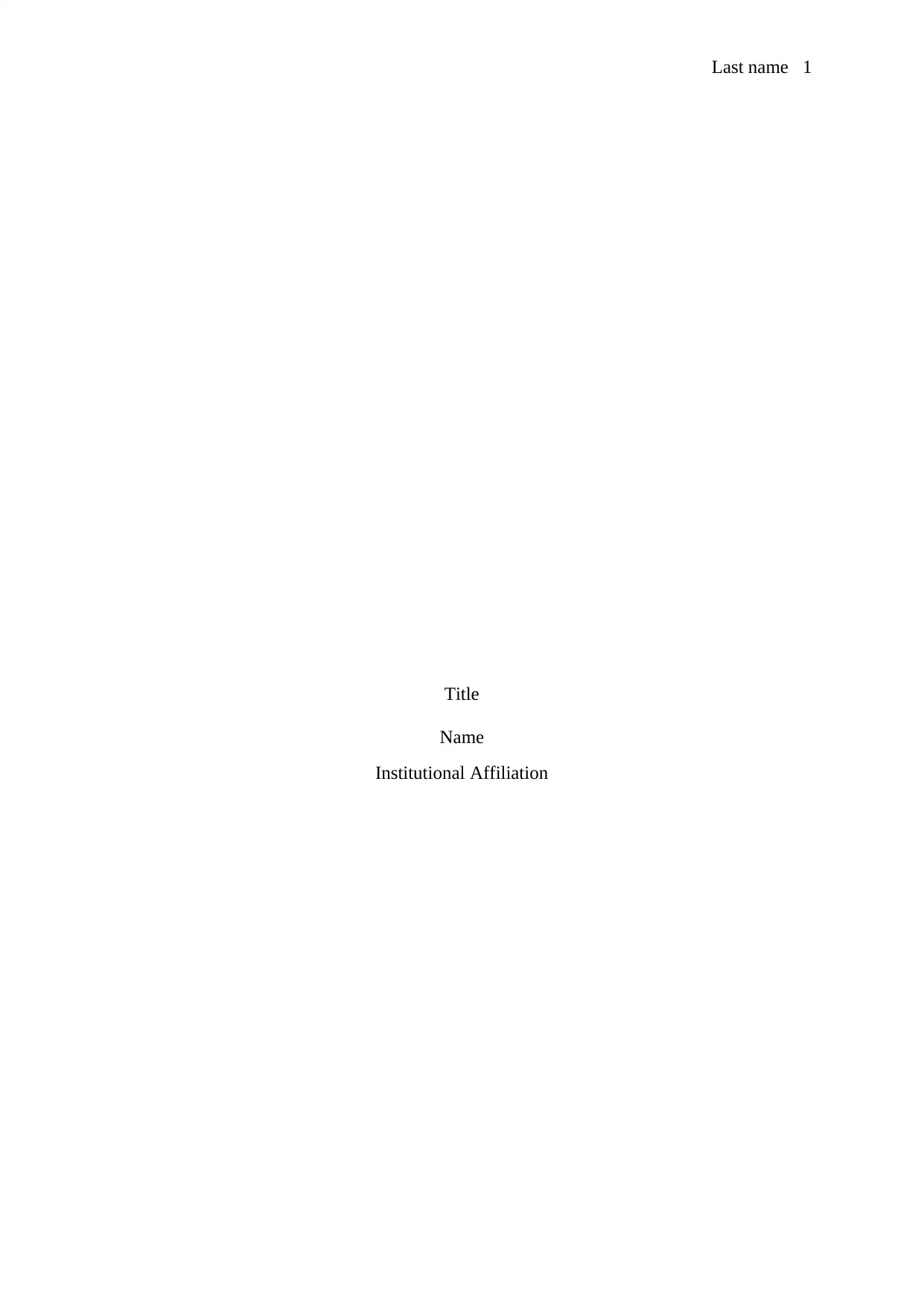
Last name 1
Title
Name
Institutional Affiliation
Title
Name
Institutional Affiliation
Paraphrase This Document
Need a fresh take? Get an instant paraphrase of this document with our AI Paraphraser

Last name 2
Abstract
In this report, the interview is done for the purpose of research work. The research topic is the
organisation and its issues. The interview is nominated as the best tool for research purposes.
Extraction of data on the topic of the organisation is purely done by the interview of
employees as they face ups and downs of organisation. Some core concepts studied in the
class, including persuasion and negotiation theories, are also elaborated. Impacts of
intercultural interaction, negotiation, meeting and conflicts of the organisation are also
discussed in this report. Lastly, a handful of suggestions or recommendations are made that
suggest how to improve the organisation. Different logic base questions are used to access the
issues and problems of organisation. It is very critical to the main organisation system in a
narrow range for its development and globalisation.
Abstract
In this report, the interview is done for the purpose of research work. The research topic is the
organisation and its issues. The interview is nominated as the best tool for research purposes.
Extraction of data on the topic of the organisation is purely done by the interview of
employees as they face ups and downs of organisation. Some core concepts studied in the
class, including persuasion and negotiation theories, are also elaborated. Impacts of
intercultural interaction, negotiation, meeting and conflicts of the organisation are also
discussed in this report. Lastly, a handful of suggestions or recommendations are made that
suggest how to improve the organisation. Different logic base questions are used to access the
issues and problems of organisation. It is very critical to the main organisation system in a
narrow range for its development and globalisation.

Last name 3
CONTENTS
Title.......................................................................................................................................................1
Abstract................................................................................................................................................2
1- Introduction.................................................................................................................................4
2- Methodology.................................................................................................................................4
3- Result/Findings............................................................................................................................5
3.1- Intercultural Communication......................................................................................................5
3.2- Negotiation & Persuasion...........................................................................................................5
4- Discussion.....................................................................................................................................6
4.1- Negotiation & Persuasion...........................................................................................................6
4.2- Meetings & Discussion...............................................................................................................7
4.3- Conflicts.....................................................................................................................................7
5- Conclusion....................................................................................................................................7
6- Recommendation.........................................................................................................................8
7- References....................................................................................................................................9
CONTENTS
Title.......................................................................................................................................................1
Abstract................................................................................................................................................2
1- Introduction.................................................................................................................................4
2- Methodology.................................................................................................................................4
3- Result/Findings............................................................................................................................5
3.1- Intercultural Communication......................................................................................................5
3.2- Negotiation & Persuasion...........................................................................................................5
4- Discussion.....................................................................................................................................6
4.1- Negotiation & Persuasion...........................................................................................................6
4.2- Meetings & Discussion...............................................................................................................7
4.3- Conflicts.....................................................................................................................................7
5- Conclusion....................................................................................................................................7
6- Recommendation.........................................................................................................................8
7- References....................................................................................................................................9
⊘ This is a preview!⊘
Do you want full access?
Subscribe today to unlock all pages.

Trusted by 1+ million students worldwide
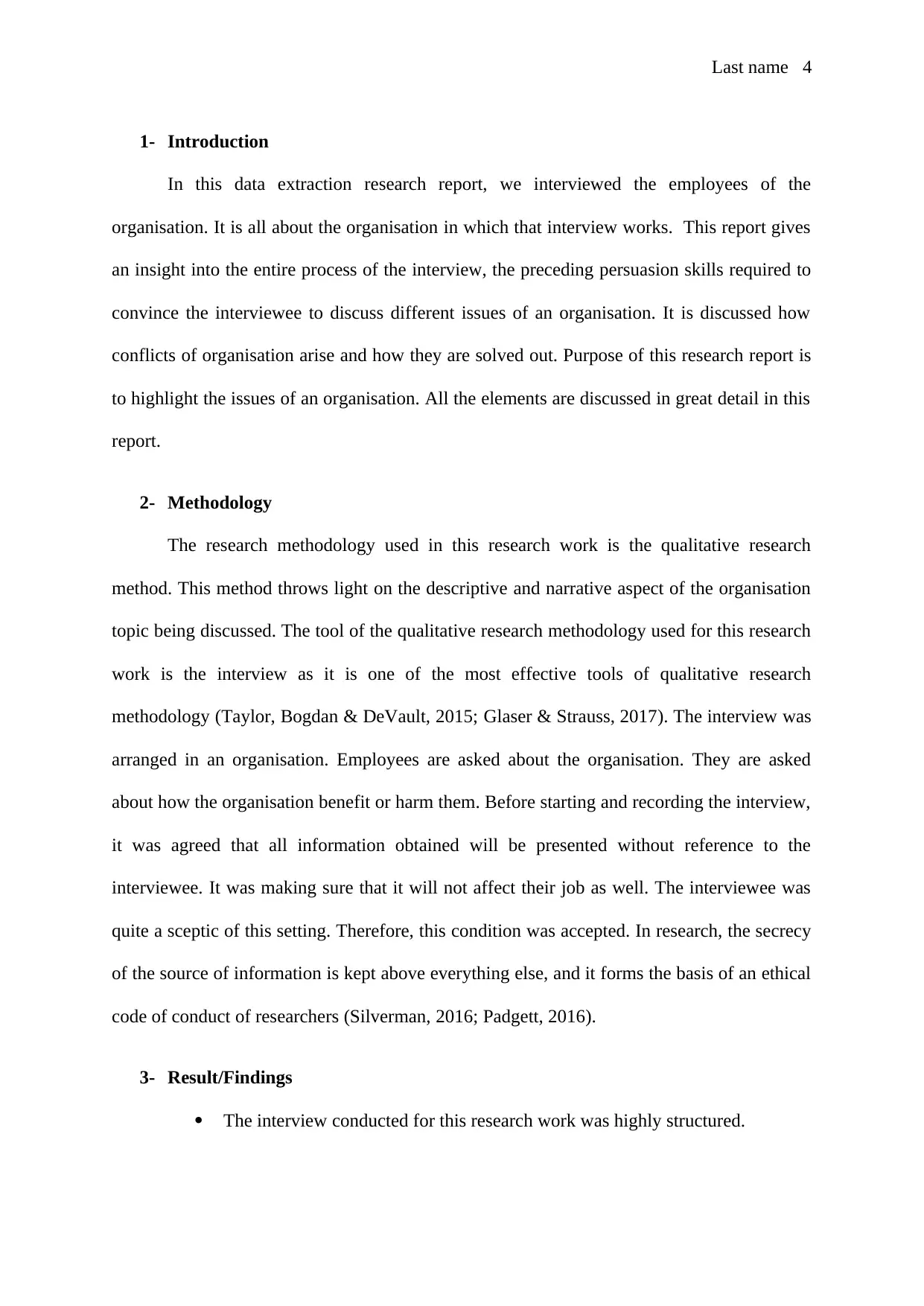
Last name 4
1- Introduction
In this data extraction research report, we interviewed the employees of the
organisation. It is all about the organisation in which that interview works. This report gives
an insight into the entire process of the interview, the preceding persuasion skills required to
convince the interviewee to discuss different issues of an organisation. It is discussed how
conflicts of organisation arise and how they are solved out. Purpose of this research report is
to highlight the issues of an organisation. All the elements are discussed in great detail in this
report.
2- Methodology
The research methodology used in this research work is the qualitative research
method. This method throws light on the descriptive and narrative aspect of the organisation
topic being discussed. The tool of the qualitative research methodology used for this research
work is the interview as it is one of the most effective tools of qualitative research
methodology (Taylor, Bogdan & DeVault, 2015; Glaser & Strauss, 2017). The interview was
arranged in an organisation. Employees are asked about the organisation. They are asked
about how the organisation benefit or harm them. Before starting and recording the interview,
it was agreed that all information obtained will be presented without reference to the
interviewee. It was making sure that it will not affect their job as well. The interviewee was
quite a sceptic of this setting. Therefore, this condition was accepted. In research, the secrecy
of the source of information is kept above everything else, and it forms the basis of an ethical
code of conduct of researchers (Silverman, 2016; Padgett, 2016).
3- Result/Findings
The interview conducted for this research work was highly structured.
1- Introduction
In this data extraction research report, we interviewed the employees of the
organisation. It is all about the organisation in which that interview works. This report gives
an insight into the entire process of the interview, the preceding persuasion skills required to
convince the interviewee to discuss different issues of an organisation. It is discussed how
conflicts of organisation arise and how they are solved out. Purpose of this research report is
to highlight the issues of an organisation. All the elements are discussed in great detail in this
report.
2- Methodology
The research methodology used in this research work is the qualitative research
method. This method throws light on the descriptive and narrative aspect of the organisation
topic being discussed. The tool of the qualitative research methodology used for this research
work is the interview as it is one of the most effective tools of qualitative research
methodology (Taylor, Bogdan & DeVault, 2015; Glaser & Strauss, 2017). The interview was
arranged in an organisation. Employees are asked about the organisation. They are asked
about how the organisation benefit or harm them. Before starting and recording the interview,
it was agreed that all information obtained will be presented without reference to the
interviewee. It was making sure that it will not affect their job as well. The interviewee was
quite a sceptic of this setting. Therefore, this condition was accepted. In research, the secrecy
of the source of information is kept above everything else, and it forms the basis of an ethical
code of conduct of researchers (Silverman, 2016; Padgett, 2016).
3- Result/Findings
The interview conducted for this research work was highly structured.
Paraphrase This Document
Need a fresh take? Get an instant paraphrase of this document with our AI Paraphraser
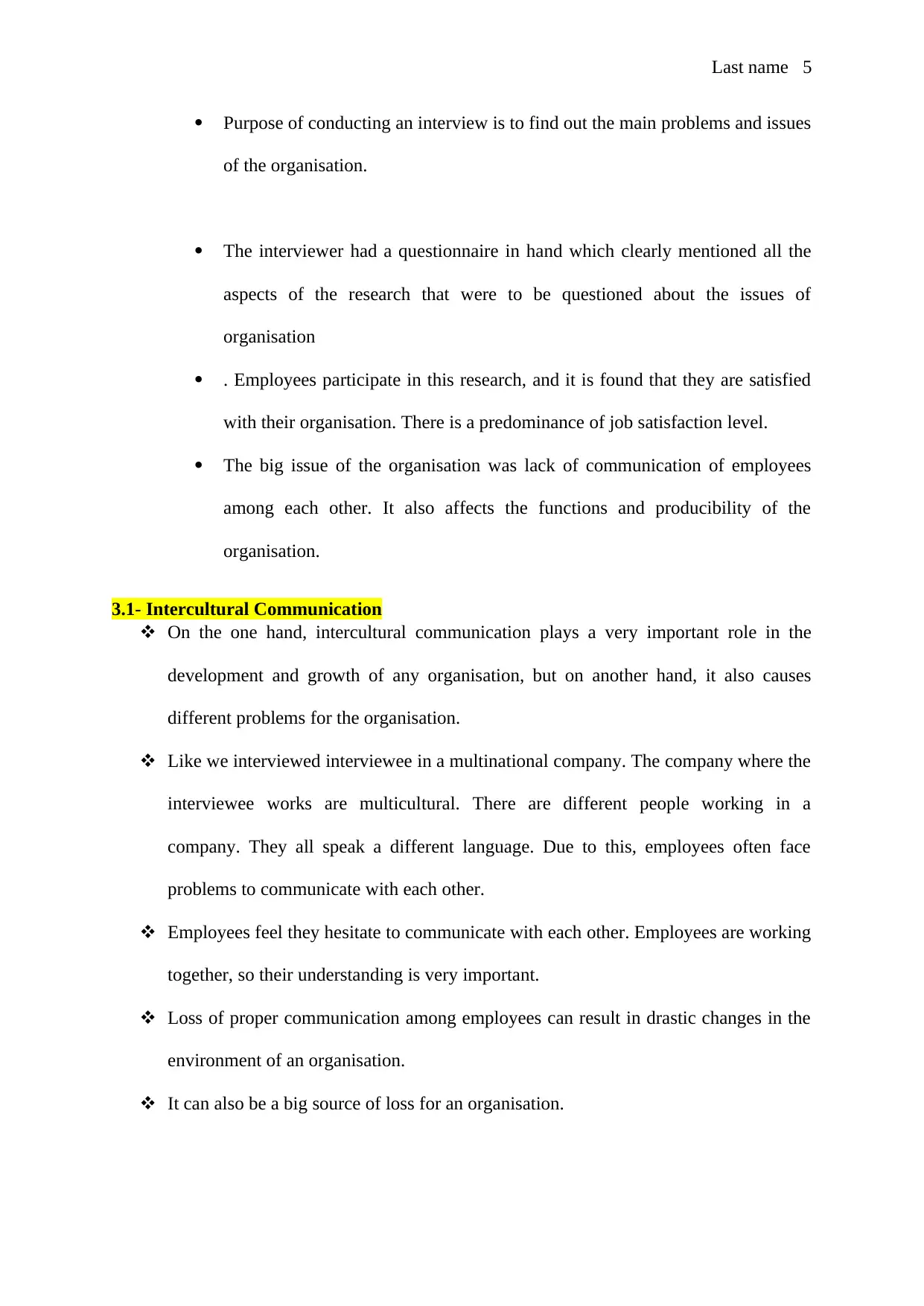
Last name 5
Purpose of conducting an interview is to find out the main problems and issues
of the organisation.
The interviewer had a questionnaire in hand which clearly mentioned all the
aspects of the research that were to be questioned about the issues of
organisation
. Employees participate in this research, and it is found that they are satisfied
with their organisation. There is a predominance of job satisfaction level.
The big issue of the organisation was lack of communication of employees
among each other. It also affects the functions and producibility of the
organisation.
3.1- Intercultural Communication
On the one hand, intercultural communication plays a very important role in the
development and growth of any organisation, but on another hand, it also causes
different problems for the organisation.
Like we interviewed interviewee in a multinational company. The company where the
interviewee works are multicultural. There are different people working in a
company. They all speak a different language. Due to this, employees often face
problems to communicate with each other.
Employees feel they hesitate to communicate with each other. Employees are working
together, so their understanding is very important.
Loss of proper communication among employees can result in drastic changes in the
environment of an organisation.
It can also be a big source of loss for an organisation.
Purpose of conducting an interview is to find out the main problems and issues
of the organisation.
The interviewer had a questionnaire in hand which clearly mentioned all the
aspects of the research that were to be questioned about the issues of
organisation
. Employees participate in this research, and it is found that they are satisfied
with their organisation. There is a predominance of job satisfaction level.
The big issue of the organisation was lack of communication of employees
among each other. It also affects the functions and producibility of the
organisation.
3.1- Intercultural Communication
On the one hand, intercultural communication plays a very important role in the
development and growth of any organisation, but on another hand, it also causes
different problems for the organisation.
Like we interviewed interviewee in a multinational company. The company where the
interviewee works are multicultural. There are different people working in a
company. They all speak a different language. Due to this, employees often face
problems to communicate with each other.
Employees feel they hesitate to communicate with each other. Employees are working
together, so their understanding is very important.
Loss of proper communication among employees can result in drastic changes in the
environment of an organisation.
It can also be a big source of loss for an organisation.
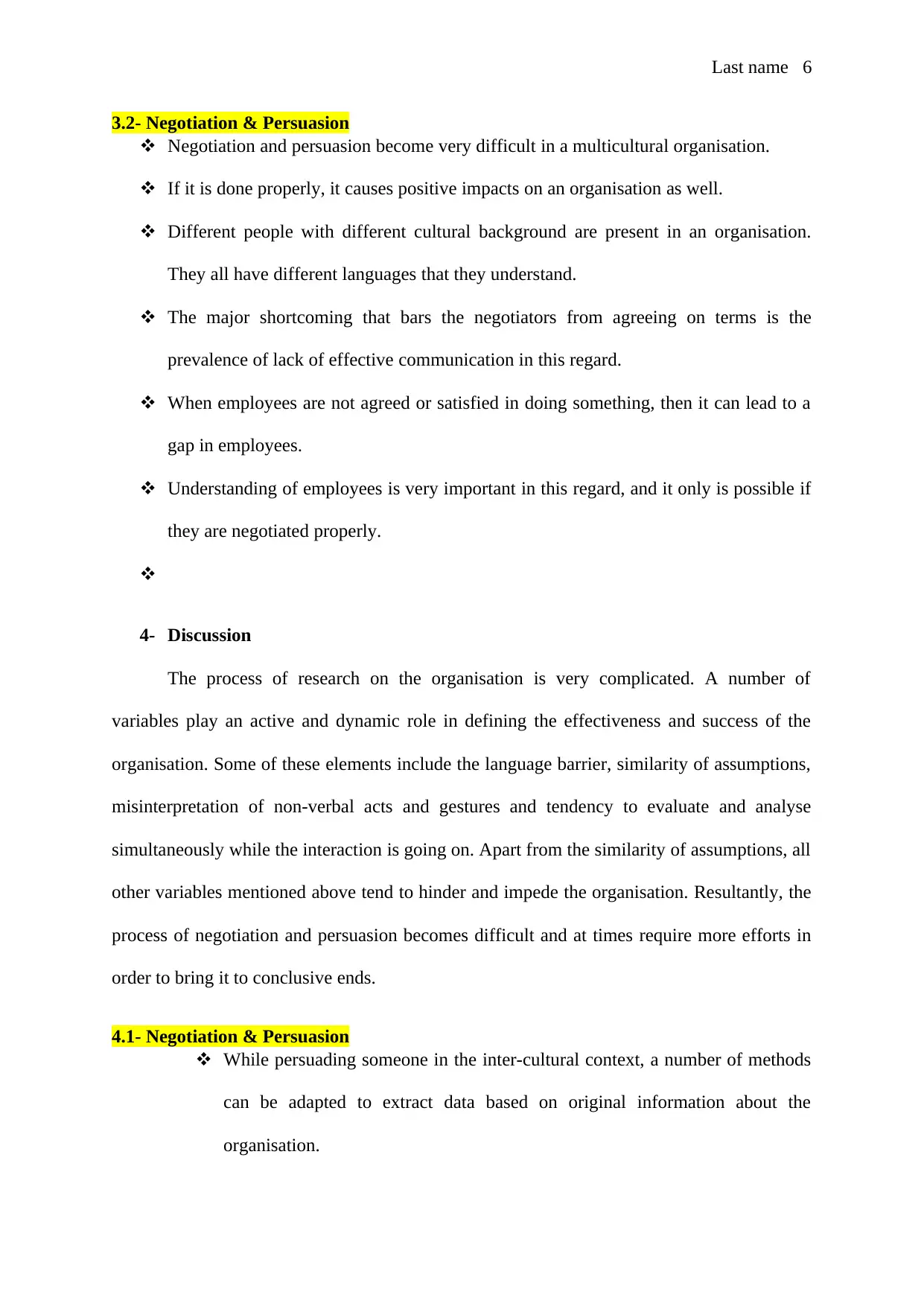
Last name 6
3.2- Negotiation & Persuasion
Negotiation and persuasion become very difficult in a multicultural organisation.
If it is done properly, it causes positive impacts on an organisation as well.
Different people with different cultural background are present in an organisation.
They all have different languages that they understand.
The major shortcoming that bars the negotiators from agreeing on terms is the
prevalence of lack of effective communication in this regard.
When employees are not agreed or satisfied in doing something, then it can lead to a
gap in employees.
Understanding of employees is very important in this regard, and it only is possible if
they are negotiated properly.
4- Discussion
The process of research on the organisation is very complicated. A number of
variables play an active and dynamic role in defining the effectiveness and success of the
organisation. Some of these elements include the language barrier, similarity of assumptions,
misinterpretation of non-verbal acts and gestures and tendency to evaluate and analyse
simultaneously while the interaction is going on. Apart from the similarity of assumptions, all
other variables mentioned above tend to hinder and impede the organisation. Resultantly, the
process of negotiation and persuasion becomes difficult and at times require more efforts in
order to bring it to conclusive ends.
4.1- Negotiation & Persuasion
While persuading someone in the inter-cultural context, a number of methods
can be adapted to extract data based on original information about the
organisation.
3.2- Negotiation & Persuasion
Negotiation and persuasion become very difficult in a multicultural organisation.
If it is done properly, it causes positive impacts on an organisation as well.
Different people with different cultural background are present in an organisation.
They all have different languages that they understand.
The major shortcoming that bars the negotiators from agreeing on terms is the
prevalence of lack of effective communication in this regard.
When employees are not agreed or satisfied in doing something, then it can lead to a
gap in employees.
Understanding of employees is very important in this regard, and it only is possible if
they are negotiated properly.
4- Discussion
The process of research on the organisation is very complicated. A number of
variables play an active and dynamic role in defining the effectiveness and success of the
organisation. Some of these elements include the language barrier, similarity of assumptions,
misinterpretation of non-verbal acts and gestures and tendency to evaluate and analyse
simultaneously while the interaction is going on. Apart from the similarity of assumptions, all
other variables mentioned above tend to hinder and impede the organisation. Resultantly, the
process of negotiation and persuasion becomes difficult and at times require more efforts in
order to bring it to conclusive ends.
4.1- Negotiation & Persuasion
While persuading someone in the inter-cultural context, a number of methods
can be adapted to extract data based on original information about the
organisation.
⊘ This is a preview!⊘
Do you want full access?
Subscribe today to unlock all pages.

Trusted by 1+ million students worldwide
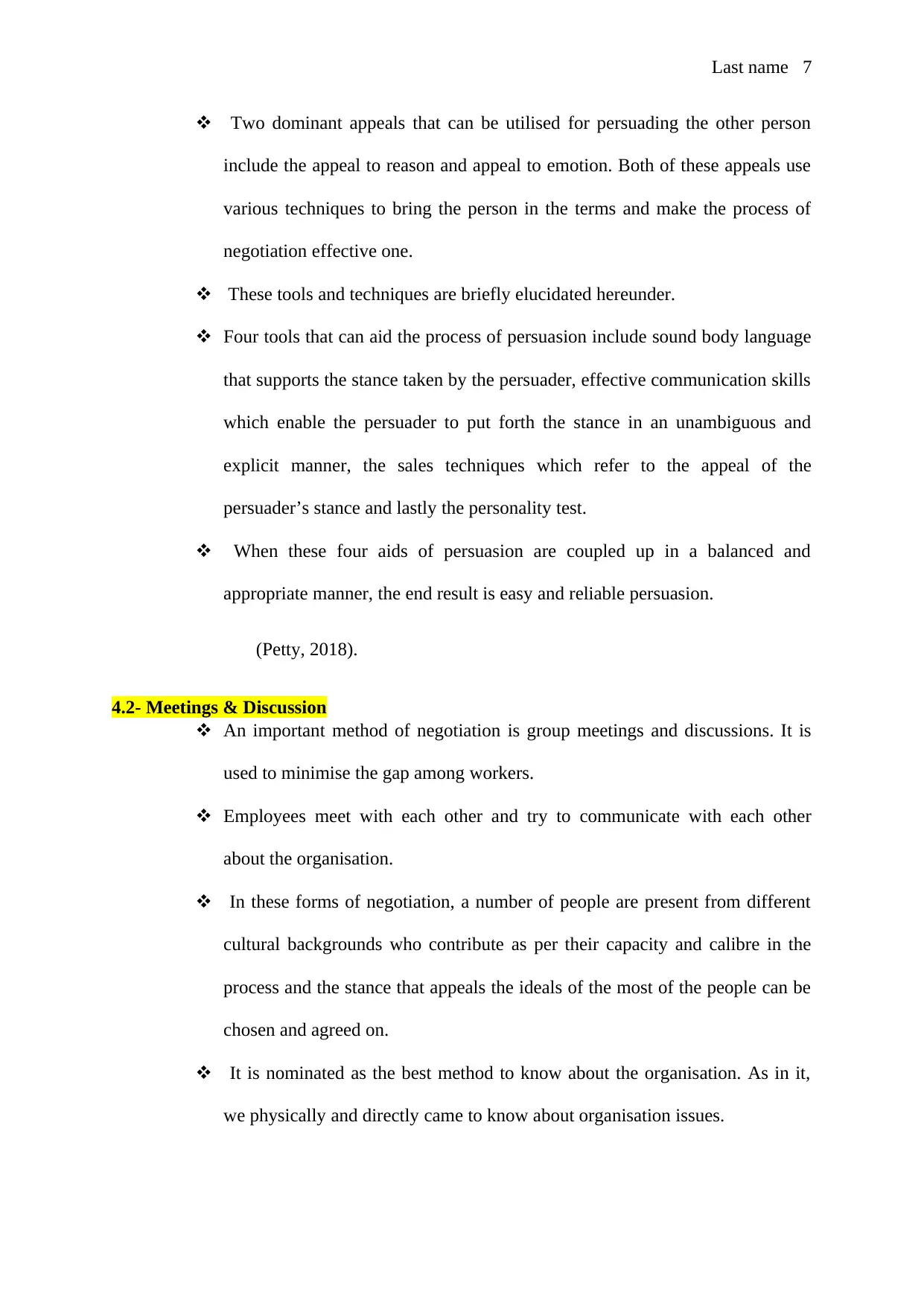
Last name 7
Two dominant appeals that can be utilised for persuading the other person
include the appeal to reason and appeal to emotion. Both of these appeals use
various techniques to bring the person in the terms and make the process of
negotiation effective one.
These tools and techniques are briefly elucidated hereunder.
Four tools that can aid the process of persuasion include sound body language
that supports the stance taken by the persuader, effective communication skills
which enable the persuader to put forth the stance in an unambiguous and
explicit manner, the sales techniques which refer to the appeal of the
persuader’s stance and lastly the personality test.
When these four aids of persuasion are coupled up in a balanced and
appropriate manner, the end result is easy and reliable persuasion.
(Petty, 2018).
4.2- Meetings & Discussion
An important method of negotiation is group meetings and discussions. It is
used to minimise the gap among workers.
Employees meet with each other and try to communicate with each other
about the organisation.
In these forms of negotiation, a number of people are present from different
cultural backgrounds who contribute as per their capacity and calibre in the
process and the stance that appeals the ideals of the most of the people can be
chosen and agreed on.
It is nominated as the best method to know about the organisation. As in it,
we physically and directly came to know about organisation issues.
Two dominant appeals that can be utilised for persuading the other person
include the appeal to reason and appeal to emotion. Both of these appeals use
various techniques to bring the person in the terms and make the process of
negotiation effective one.
These tools and techniques are briefly elucidated hereunder.
Four tools that can aid the process of persuasion include sound body language
that supports the stance taken by the persuader, effective communication skills
which enable the persuader to put forth the stance in an unambiguous and
explicit manner, the sales techniques which refer to the appeal of the
persuader’s stance and lastly the personality test.
When these four aids of persuasion are coupled up in a balanced and
appropriate manner, the end result is easy and reliable persuasion.
(Petty, 2018).
4.2- Meetings & Discussion
An important method of negotiation is group meetings and discussions. It is
used to minimise the gap among workers.
Employees meet with each other and try to communicate with each other
about the organisation.
In these forms of negotiation, a number of people are present from different
cultural backgrounds who contribute as per their capacity and calibre in the
process and the stance that appeals the ideals of the most of the people can be
chosen and agreed on.
It is nominated as the best method to know about the organisation. As in it,
we physically and directly came to know about organisation issues.
Paraphrase This Document
Need a fresh take? Get an instant paraphrase of this document with our AI Paraphraser

Last name 8
4.3- Conflicts
Lastly, a variety of elements are involved in causing conflicts in an
organisation.
Conflict can occur due to a lack of communication in an organisation.
In order to escape the potential commencement of the conflict, all the
elements should be neutralised.
The element of conflict can successfully be avoided only if a systematic and
standardised approach is followed.
5- Conclusion
Inter-cultural communications and interactions come up with a lot of many problems.
In order to avoid these discrepancies to perpetuate, the inter-cultural barriers should be
removed as much and as long as possible. Taking the consent of the interviewee for the
interview is the first and the foremost necessity. No transfer of information or publication of
information can be done without the permission of the interviewee. The tool of interviews
can help the qualitative research methodology a lot only if the standards are maintained. In
the end, by the usage of effective techniques such as negotiation, persuasion, intercultural
communication and standard interviews, the aims and objectives of the research can be
achieved.
6- Recommendation
Keeping the results and findings in mind, some workable suggestions are made
hereunder. These suggestions are made keeping in mind the shortcomings witnessed in the
process of conducting the interview.
The interviewee should be given as much space and freedom as possible in order to
get to know exact and authentic information.
4.3- Conflicts
Lastly, a variety of elements are involved in causing conflicts in an
organisation.
Conflict can occur due to a lack of communication in an organisation.
In order to escape the potential commencement of the conflict, all the
elements should be neutralised.
The element of conflict can successfully be avoided only if a systematic and
standardised approach is followed.
5- Conclusion
Inter-cultural communications and interactions come up with a lot of many problems.
In order to avoid these discrepancies to perpetuate, the inter-cultural barriers should be
removed as much and as long as possible. Taking the consent of the interviewee for the
interview is the first and the foremost necessity. No transfer of information or publication of
information can be done without the permission of the interviewee. The tool of interviews
can help the qualitative research methodology a lot only if the standards are maintained. In
the end, by the usage of effective techniques such as negotiation, persuasion, intercultural
communication and standard interviews, the aims and objectives of the research can be
achieved.
6- Recommendation
Keeping the results and findings in mind, some workable suggestions are made
hereunder. These suggestions are made keeping in mind the shortcomings witnessed in the
process of conducting the interview.
The interviewee should be given as much space and freedom as possible in order to
get to know exact and authentic information.
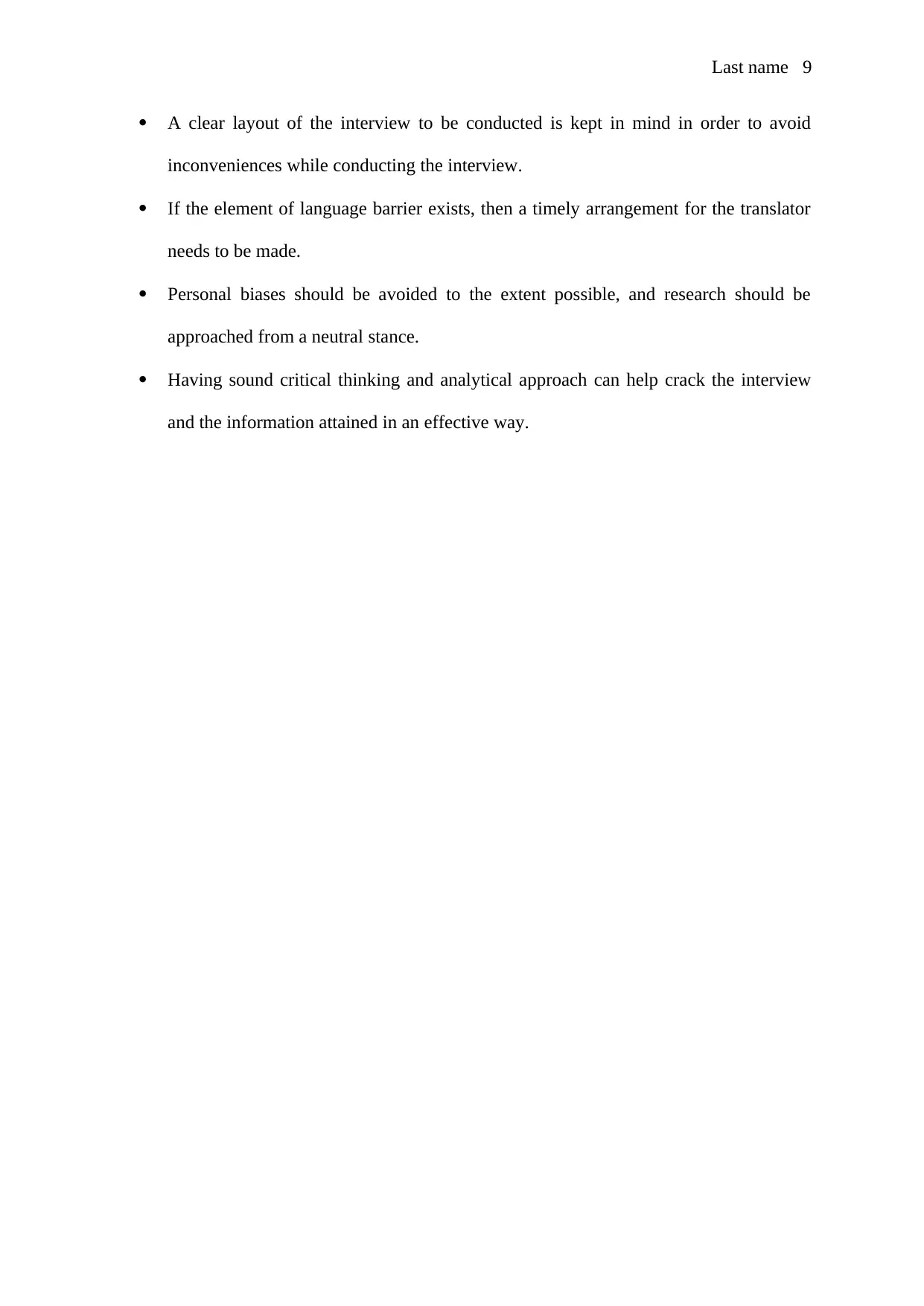
Last name 9
A clear layout of the interview to be conducted is kept in mind in order to avoid
inconveniences while conducting the interview.
If the element of language barrier exists, then a timely arrangement for the translator
needs to be made.
Personal biases should be avoided to the extent possible, and research should be
approached from a neutral stance.
Having sound critical thinking and analytical approach can help crack the interview
and the information attained in an effective way.
A clear layout of the interview to be conducted is kept in mind in order to avoid
inconveniences while conducting the interview.
If the element of language barrier exists, then a timely arrangement for the translator
needs to be made.
Personal biases should be avoided to the extent possible, and research should be
approached from a neutral stance.
Having sound critical thinking and analytical approach can help crack the interview
and the information attained in an effective way.
⊘ This is a preview!⊘
Do you want full access?
Subscribe today to unlock all pages.

Trusted by 1+ million students worldwide
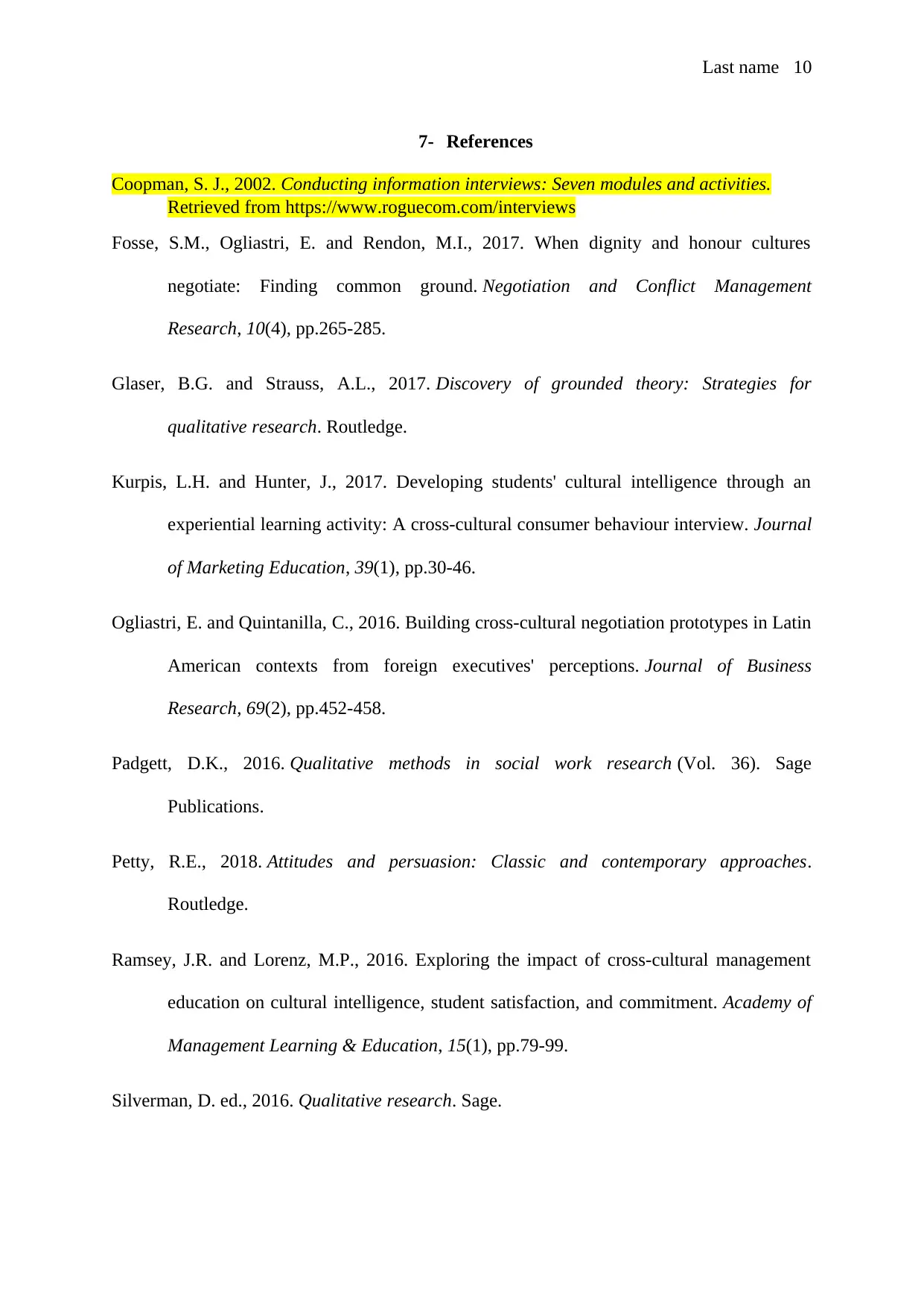
Last name 10
7- References
Coopman, S. J., 2002. Conducting information interviews: Seven modules and activities.
Retrieved from https://www.roguecom.com/interviews
Fosse, S.M., Ogliastri, E. and Rendon, M.I., 2017. When dignity and honour cultures
negotiate: Finding common ground. Negotiation and Conflict Management
Research, 10(4), pp.265-285.
Glaser, B.G. and Strauss, A.L., 2017. Discovery of grounded theory: Strategies for
qualitative research. Routledge.
Kurpis, L.H. and Hunter, J., 2017. Developing students' cultural intelligence through an
experiential learning activity: A cross-cultural consumer behaviour interview. Journal
of Marketing Education, 39(1), pp.30-46.
Ogliastri, E. and Quintanilla, C., 2016. Building cross-cultural negotiation prototypes in Latin
American contexts from foreign executives' perceptions. Journal of Business
Research, 69(2), pp.452-458.
Padgett, D.K., 2016. Qualitative methods in social work research (Vol. 36). Sage
Publications.
Petty, R.E., 2018. Attitudes and persuasion: Classic and contemporary approaches.
Routledge.
Ramsey, J.R. and Lorenz, M.P., 2016. Exploring the impact of cross-cultural management
education on cultural intelligence, student satisfaction, and commitment. Academy of
Management Learning & Education, 15(1), pp.79-99.
Silverman, D. ed., 2016. Qualitative research. Sage.
7- References
Coopman, S. J., 2002. Conducting information interviews: Seven modules and activities.
Retrieved from https://www.roguecom.com/interviews
Fosse, S.M., Ogliastri, E. and Rendon, M.I., 2017. When dignity and honour cultures
negotiate: Finding common ground. Negotiation and Conflict Management
Research, 10(4), pp.265-285.
Glaser, B.G. and Strauss, A.L., 2017. Discovery of grounded theory: Strategies for
qualitative research. Routledge.
Kurpis, L.H. and Hunter, J., 2017. Developing students' cultural intelligence through an
experiential learning activity: A cross-cultural consumer behaviour interview. Journal
of Marketing Education, 39(1), pp.30-46.
Ogliastri, E. and Quintanilla, C., 2016. Building cross-cultural negotiation prototypes in Latin
American contexts from foreign executives' perceptions. Journal of Business
Research, 69(2), pp.452-458.
Padgett, D.K., 2016. Qualitative methods in social work research (Vol. 36). Sage
Publications.
Petty, R.E., 2018. Attitudes and persuasion: Classic and contemporary approaches.
Routledge.
Ramsey, J.R. and Lorenz, M.P., 2016. Exploring the impact of cross-cultural management
education on cultural intelligence, student satisfaction, and commitment. Academy of
Management Learning & Education, 15(1), pp.79-99.
Silverman, D. ed., 2016. Qualitative research. Sage.
Paraphrase This Document
Need a fresh take? Get an instant paraphrase of this document with our AI Paraphraser

Last name 11
Taylor, S.J., Bogdan, R. and DeVault, M., 2015. Introduction to qualitative research
methods: A guidebook and resource. John Wiley & Sons.
Verlegh, P.W., Fransen, M.L. and Kirmani, A., 2015. Persuasion in advertising: when does it
work, and when does it not?
Taylor, S.J., Bogdan, R. and DeVault, M., 2015. Introduction to qualitative research
methods: A guidebook and resource. John Wiley & Sons.
Verlegh, P.W., Fransen, M.L. and Kirmani, A., 2015. Persuasion in advertising: when does it
work, and when does it not?
1 out of 11
Related Documents
Your All-in-One AI-Powered Toolkit for Academic Success.
+13062052269
info@desklib.com
Available 24*7 on WhatsApp / Email
![[object Object]](/_next/static/media/star-bottom.7253800d.svg)
Unlock your academic potential
Copyright © 2020–2025 A2Z Services. All Rights Reserved. Developed and managed by ZUCOL.




